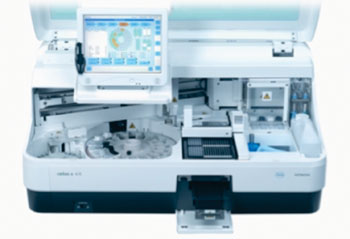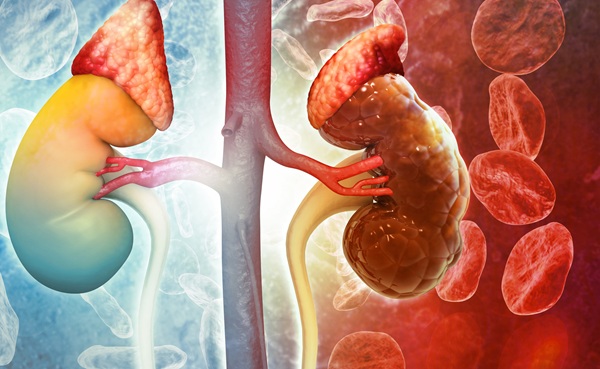Rapid Automated Immunoassay for HTLV I/II Antibodies Now Available
|
By LabMedica International staff writers Posted on 05 Aug 2015 |

Image: The Elecsys benchtop analyzer was designed for small to medium workloads (Photo courtesy of Roche).
An automated immunoassay for the detection of antibodies against human T-lymphotropic virus I or II (HTLV-I/II) in donated blood and routine diagnostic samples and is now available for use by blood centers and clinical laboratories.
The Roche (Basel, Switzerland) HTLV-I/II immunoassay was designed for use on the Elecsys benchtop analyzer. This IVD instrument is powered by enhanced chemiluminescence (ECL) technology, which provides precise and reliable patient results that contribute to better patient care.
The Elecys instrument uses two electrochemically active substances, a ruthenium complex and tripropylamine (TPA). These reagents are involved in the reaction that leads to the emission of light. Ruthenium and TPA are non-isotopic and highly stable at base state. Only when voltage is applied and the labeled compound is repeatedly excited do the reactants begin emitting photons. To start the reaction, voltage is applied between the working and counter electrode, and an electrical field is created, ensuring a precisely controlled and timed reaction.
The operation is performed on a solution containing sample and reagents that are aspirated into the measuring cell. A magnetic field is applied, and the paramagnetic beads (coated with antigen/antibody complexes bound by streptavidin-biotin) are bound to the surface of the measuring cell. ProCell solution is introduced in order to separate the bound immunoassay complexes from the free remaining particles and to provide TPA, which is essential for the ECL-reaction. The test procedure requires about 18 minutes to run a single test.
“Globally there are around 20 million people infected with HTLV-I/II, many of whom are unknown carriers. If the virus is undetected in donors, the risk of spreading the infection increases,” said Roland Diggelmann, COO of the Roche Diagnostics Division. “Roche is uniquely positioned to help blood centers improve their testing efficiency, based on our broad assay portfolio and integrated molecular and serology laboratory solutions.”
Related Links:
Roche
The Roche (Basel, Switzerland) HTLV-I/II immunoassay was designed for use on the Elecsys benchtop analyzer. This IVD instrument is powered by enhanced chemiluminescence (ECL) technology, which provides precise and reliable patient results that contribute to better patient care.
The Elecys instrument uses two electrochemically active substances, a ruthenium complex and tripropylamine (TPA). These reagents are involved in the reaction that leads to the emission of light. Ruthenium and TPA are non-isotopic and highly stable at base state. Only when voltage is applied and the labeled compound is repeatedly excited do the reactants begin emitting photons. To start the reaction, voltage is applied between the working and counter electrode, and an electrical field is created, ensuring a precisely controlled and timed reaction.
The operation is performed on a solution containing sample and reagents that are aspirated into the measuring cell. A magnetic field is applied, and the paramagnetic beads (coated with antigen/antibody complexes bound by streptavidin-biotin) are bound to the surface of the measuring cell. ProCell solution is introduced in order to separate the bound immunoassay complexes from the free remaining particles and to provide TPA, which is essential for the ECL-reaction. The test procedure requires about 18 minutes to run a single test.
“Globally there are around 20 million people infected with HTLV-I/II, many of whom are unknown carriers. If the virus is undetected in donors, the risk of spreading the infection increases,” said Roland Diggelmann, COO of the Roche Diagnostics Division. “Roche is uniquely positioned to help blood centers improve their testing efficiency, based on our broad assay portfolio and integrated molecular and serology laboratory solutions.”
Related Links:
Roche
Latest Hematology News
- MRD Tests Could Predict Survival in Leukemia Patients
- Platelet Activity Blood Test in Middle Age Could Identify Early Alzheimer’s Risk
- Microvesicles Measurement Could Detect Vascular Injury in Sickle Cell Disease Patients
- ADLM’s New Coagulation Testing Guidance to Improve Care for Patients on Blood Thinners
- Viscoelastic Testing Could Improve Treatment of Maternal Hemorrhage
- Pioneering Model Measures Radiation Exposure in Blood for Precise Cancer Treatments
- Platelets Could Improve Early and Minimally Invasive Detection of Cancer
- Portable and Disposable Device Obtains Platelet-Rich Plasma Without Complex Equipment
- Disposable Cartridge-Based Test Delivers Rapid and Accurate CBC Results
- First Point-of-Care Heparin Monitoring Test Provides Results in Under 15 Minutes

- New Scoring System Predicts Risk of Developing Cancer from Common Blood Disorder
- Non-Invasive Prenatal Test for Fetal RhD Status Demonstrates 100% Accuracy
- WBC Count Could Predict Severity of COVID-19 Symptoms
- New Platelet Counting Technology to Help Labs Prevent Diagnosis Errors
- Streamlined Approach to Testing for Heparin-Induced Thrombocytopenia Improves Diagnostic Accuracy
- POC Hemostasis System Could Help Prevent Maternal Deaths
Channels
Clinical Chemistry
view channel
POC Breath Diagnostic System to Detect Pneumonia-Causing Pathogens
Pseudomonas aeruginosa is a major cause of hospital-acquired and ventilator-associated pneumonia, particularly in lung transplant recipients and patients with structural lung disease. Its ability to form... Read more
Online Tool Detects Drug Exposure Directly from Patient Samples
Doctors often rely on patient interviews and medical records to determine what medications a person has taken, but this information is frequently incomplete. People may forget drugs they used, take over-the-counter... Read moreMolecular Diagnostics
view channel
Blood Biomarker Improves Early Brain Injury Prognosis After Cardiac Arrest
After a cardiac arrest, many patients remain unconscious for days, leaving doctors and families facing uncertainty about whether meaningful recovery is possible. Current tools to assess brain damage, including... Read more
Biomarkers Could Identify Patients at High Risk of Severe AKI After Major Surgery
Acute kidney injury is one of the most common and dangerous complications after major surgery, particularly among patients in intensive care. Even mild impairment of kidney function can lead to long-term... Read more
CLIA Test Identifies Head and Neck Cancer Recurrence from Post-Surgical Lymphatic Fluid
While the lymphatic system’s critical role in metastasis has long been recognized, routine access to patient lymph has been elusive. Now, a non-invasive process can access lymph through the collection... Read moreHematology
view channel
MRD Tests Could Predict Survival in Leukemia Patients
Acute myeloid leukemia is an aggressive blood cancer that disrupts normal blood cell production and often relapses even after intensive treatment. Clinicians currently lack early, reliable markers to predict... Read more
Platelet Activity Blood Test in Middle Age Could Identify Early Alzheimer’s Risk
Early detection of Alzheimer’s disease remains one of the biggest unmet needs in neurology, particularly because the biological changes underlying the disorder begin decades before memory symptoms appear.... Read more
Microvesicles Measurement Could Detect Vascular Injury in Sickle Cell Disease Patients
Assessing disease severity in sickle cell disease (SCD) remains challenging, especially when trying to predict hemolysis, vascular injury, and risk of complications such as vaso-occlusive crises.... Read more
ADLM’s New Coagulation Testing Guidance to Improve Care for Patients on Blood Thinners
Direct oral anticoagulants (DOACs) are one of the most common types of blood thinners. Patients take them to prevent a host of complications that could arise from blood clotting, including stroke, deep... Read moreImmunology
view channelBlood Test Could Detect Adverse Immunotherapy Effects
Immune checkpoint inhibitors have transformed cancer treatment, but they can also trigger serious immune-related adverse events that damage healthy organs and may become life-threatening if not detected early.... Read more
Routine Blood Test Can Predict Who Benefits Most from CAR T-Cell Therapy
CAR T-cell therapy has transformed treatment for patients with relapsed or treatment-resistant non-Hodgkin lymphoma, but many patients eventually relapse despite an initial response. Clinicians currently... Read moreMicrobiology
view channel
Blood-Based Diagnostic Method Could Identify Pediatric LRTIs
Lower-respiratory tract infections (LRTIs) are a leading cause of illness and death worldwide, and pneumonia is the leading infectious cause of death in children under five, claiming the lives of over... Read more
Rapid Diagnostic Test Matches Gold Standard for Sepsis Detection
Sepsis kills 11 million people worldwide every year and generates massive healthcare costs. In the USA and Europe alone, sepsis accounts for USD 100 billion in annual hospitalization expenses.... Read moreRapid POC Tuberculosis Test Provides Results Within 15 Minutes
Tuberculosis remains one of the world’s deadliest infectious diseases, and reducing new cases depends on identifying individuals with latent infection before it progresses. Current diagnostic tools often... Read more
Rapid Assay Identifies Bloodstream Infection Pathogens Directly from Patient Samples
Bloodstream infections in sepsis progress quickly and demand rapid, precise diagnosis. Current blood-culture methods often take one to five days to identify the pathogen, leaving clinicians to treat blindly... Read morePathology
view channel
Rapid Low-Cost Tests Can Prevent Child Deaths from Contaminated Medicinal Syrups
Medicinal syrups contaminated with toxic chemicals have caused the deaths of hundreds of children worldwide, exposing a critical gap in how these products are tested before reaching patients.... Read more
Tumor Signals in Saliva and Blood Enable Non-Invasive Monitoring of Head and Neck Cancer
Head and neck cancers are among the most aggressive malignancies worldwide, with nearly 900,000 new cases diagnosed each year. Monitoring these cancers for recurrence or relapse typically relies on tissue... Read more
Common Health Issues Can Influence New Blood Tests for Alzheimer’s Disease
Blood-based tests for Alzheimer’s disease are transforming diagnosis by offering a simpler alternative to spinal taps and brain imaging. However, many people evaluated at memory clinics also live with... Read more
Blood Test Formula Identifies Chronic Liver Disease Patients with Higher Cancer Risk
Chronic liver disease affects millions worldwide and can progress silently to hepatocellular carcinoma (HCC), one of the deadliest cancers globally. While surveillance guidelines exist for patients with... Read moreIndustry
view channel
BD and Penn Institute Collaborate to Advance Immunotherapy through Flow Cytometry
BD (Becton, Dickinson and Company, Franklin Lakes, NJ, USA) has entered into a strategic collaboration with the Institute for Immunology and Immune Health (I3H, Philadelphia, PA, USA) at the University... Read more


















